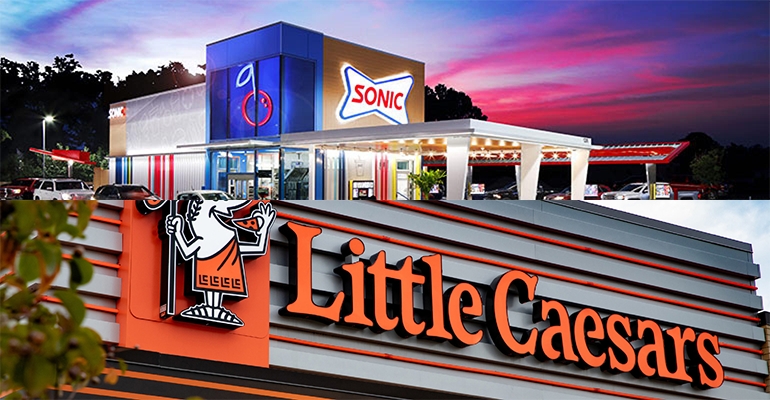If founders, chefs and other creatives are the beating heart of the restaurant industry, then franchisees are the veins delivering their ideas to all corners of the globe. Franchising is critical to the success of the industry, allowing brands to quickly scale their big ideas using other people’s capital. And whether it’s a mom-and-pop restaurant owner with one or two franchised restaurants or a seasoned veteran whose influence in the industry is well-known, franchisees — with all their individual attributes, styles and personalities — make a huge impact on the success of a business.
In NRN’s first Franchisee Spotlight, we’re featuring Mike James, who owns 127 Little Caesars and Sonic restaurants nationally, mostly in rural Illinois, Louisiana and Texas. The Sonic restaurants are operated under Guernsey Holdings LLC. We spoke with James about his path to buying nearly 150 restaurants in just a few years and his connection to the mainly rural communities where his restaurants operate.
Store breakdown
Little Caesars: 40 units
Sonic Drive-In: 87 units
 Backstory
Backstory
“Fresh out of college in 2010, I went into commercial real estate brokerage. I was working with a lot of franchisees on building their real estate portfolios or helping advise them on what to do with real estate, so that was my first touchpoint in the restaurant space. About five years into that, I started to get excited about potentially becoming a franchisee myself. I saw the lifestyle and the connectivity with employees. About three years ago, I bought my first business, 21 Little Caesars, and I got that business up to about 40 units.
Why Sonic
“I took a step back after that and said I wanted to find a brand that I could grow significantly and that I was passionate about. I pulled up to a Sonic in Palm Springs and it was this ‘aha’ moment, where I fell in love with the brand. And then I spent some time getting to know the people within the brand. I found a deal to buy the first 10 units in rural Illinois and I partnered with the right people, and we just started growing.”
Growth strategy
“We opened our first Sonic almost a year ago to the day in April 2021. So far, we have acquired all of the restaurants we own today. But we actually just toured a bunch of lots where we’re anticipating building seven Sonics. We plan on acquiring quite a few more, and the long-term vision is to get to 400-500 Sonic restaurants in the first five years, and about 50-100 of those will be by way of development and the rest by acquisition.”
What is your passion
“The thing that got me excited about the business is when I saw a store-level employee that came from a rough neighborhood being given an opportunity and then they become a store manager, and then they become an area supervisor and worked their way up. I think that connectivity towards the people and the cultural side is really what sparked my interest. Like, if you walk into a Sonic that's really well-run, people are excited and there's a ton of energy around it. It’s a high intensity business, so I think it attracts a unique type of employee.”
Community connection
“Our employees are intertwined with the community in a whole different way. They know their customers’ names, their orders, they know what's going on in their lives. We probably employ about 40 people per store and in a town of 4,000 people, that’s meaningful because there’s not a lot of places in town that you can work where it’s exciting. And since we have more than 100 restaurants, opportunity exists. If you excel at one location, another opportunity could present itself. In Houston, we bought these 18 units from a group that had owned them forever and the needed love and opportunity to be reinvigorated.”
Biggest challenges
“The labor pressures have obviously been something everyone's talking about. There’s been wage inflation for quite some time now, though it seems to be easing a little bit. However, in our rural markets especially, it’s tough to find qualified people to work in the restaurants.”
Bigger solutions
“If I walk into a restaurant, I could tell you within five seconds what kind of leadership and culture you have there. I can probably tell you what the turnover rate is, what kind of volume the restaurant is, etc. We’ve bought some restaurants that needed more of a turnaround, and we needed to rebuild that culture by incentivizing the team, having the right compensation that is tied to profitability at the restaurant, giving them a true stake in the business, and having them aligned on our customer service and the quality of the product. So having the team aligned from a cultural and financial perspective to hit our targets is crucial.”
What franchisees need from franchisors
“We need real guidance that we can bank on. In this kind of environment, everything from the products, the marketing campaigns, to the commodity side, is important — you want to know your product is going to get there at a fair price. And you want to know that the things that you're spending your time and resources and money on that you can rely upon the decisions that are being made at 30,000 feet. You want to know the executives are tied to the restaurant; you don’t want this ivory tower mentality.”
The story behind the success
“In very short order, we became one of the premier operators, and part of that is because of our connection to the restaurants. I’m in our restaurants constantly. And even though we come from a strong financial background, we're not your mom-and-pop business that built every store from the ground up. But we have significant development deals for the future. The real reason why we are unique is that we are not a private equity firm So not only are we buying a ton of units, we're investing in them, and making sure they're up to snuff. If at any point we fell below certain operational metrics, we would stop buying units until we are back in the top 10% of the industry, performance-wise.”
This interview was edited for clarity.





![Smoothie King Ribbon Cutting Terminal A_01[95].jpg](https://www.nrn.com/sites/nrn.com/files/styles/article_related_thumb_standard/public/Smoothie%20King%20Ribbon%20Cutting%20Terminal%20A_0195.jpg?itok=WNYpNsAy)